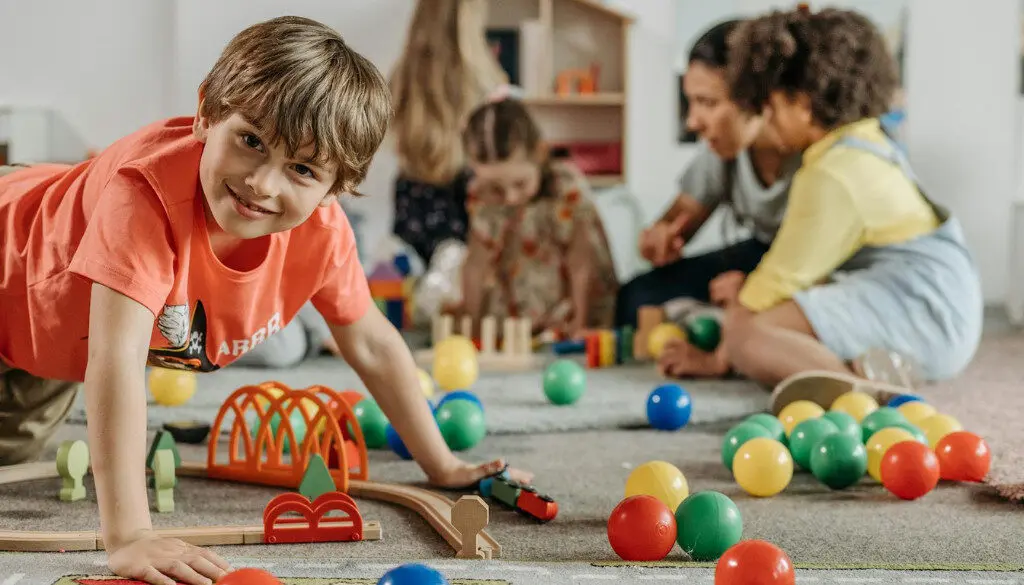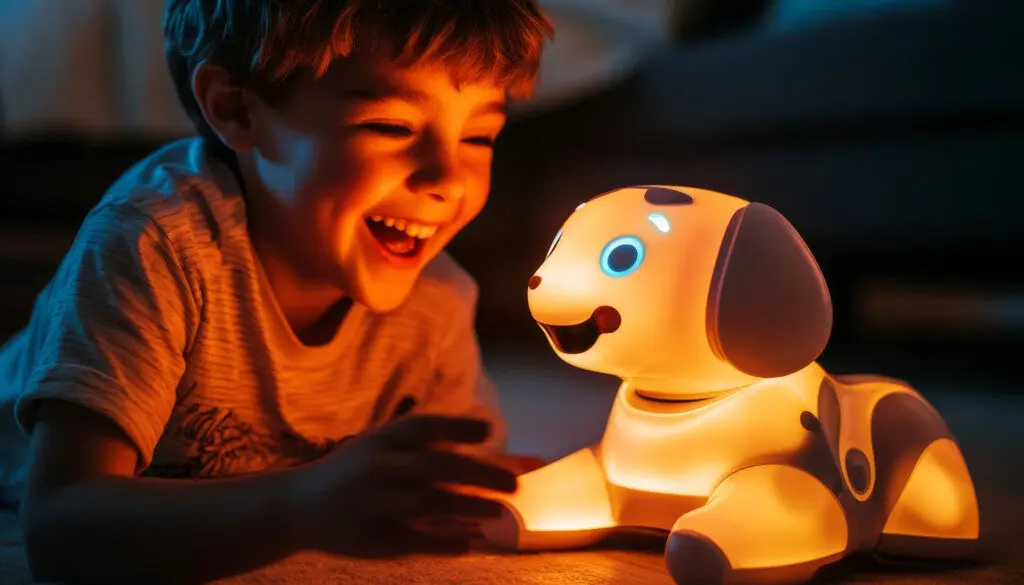As a busy mom, you might wonder how to balance childcare, household chores, and personal time. You want to make sure your toddler gets the best education. Creating a homeschooling routine can change everything. It helps your child learn important skills and brings order to your day.
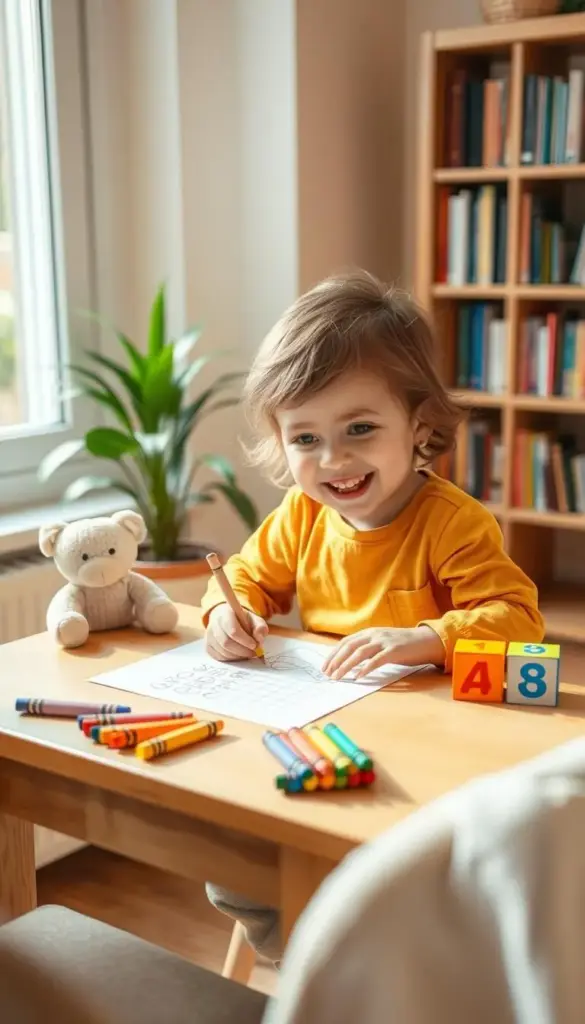
Picture a daily plan that lets you do fun, educational things with your toddler. It also gives you some time for yourself. A good home schooling routine makes this possible. It includes activities that are both fun and educational, helping your child grow and learn.
Key Takeaways
- Establishing a homeschooling routine helps create a structured and predictable daily schedule.
- A well-planned routine incorporates fun, educational activities that foster your toddler’s growth.
- Setting achievable goals is key for a successful homeschooling experience.
- A homeschooling routine allows you to balance childcare and personal time effectively.
- Engaging in activities with your toddler strengthens your bond and promotes learning.
Understanding Your Toddler’s Learning Style and Needs
Every toddler is unique, and knowing their learning needs is key to homeschooling. It’s important to understand how your child learns and grows. This helps you tailor your homeschooling to fit their needs.
Developmental Milestones for Toddlers Ages 1-3
Toddlers from 1 to 3 years old go through big changes. They start to move better, talk more, and solve problems. Watching these milestones helps you see how your child is doing and adjust your homeschooling plan.
- Physical milestones: walking, running, and improving fine motor skills.
- Cognitive milestones: problem-solving, understanding cause and effect.
- Language milestones: saying a few words, combining words into simple sentences.
Different Learning Styles in Young Children
Children learn in different ways, which affects how they learn. The main styles are visual, auditory, and kinesthetic. Knowing your toddler’s style helps you teach them better.
For example, a visual learner might like watching videos or using flashcards. An auditory learner might enjoy listening to stories or songs. Kinesthetic learners do best with hands-on activities and play.
Setting Realistic Educational Goals for Toddlers
Setting reachable educational goals is important for homeschooling. These goals should match your child’s age and learning style. Realistic goals help create a learning space that supports your child’s growth.
Break down big goals into smaller tasks. For example, to improve vocabulary, start with a few new words each day. Use stories and games to make it fun.
Creating the Perfect Learning Environment at Home
Turning a corner of your home into a learning space can really help your toddler learn. A neat and welcoming area encourages a love for learning. It also keeps your child on track.
Designating a Dedicated Learning Space
Having a special area for learning is key. This spot should be quiet, comfy, and safe. Think about these things when setting it up:
- Find a spot with natural light to improve mood and energy.
- Make sure the area is well-ventilated to keep your child alert.
- Use furniture that’s right for their size.
Essential Materials and Supplies for Toddler Learning
Having the right stuff in your learning space is important. Here are some basics to start with:
| Material | Description | Benefits |
|---|---|---|
| Art Supplies | Crayons, markers, paint, and coloring books | Boosts creativity and fine motor skills |
| Educational Toys | Puzzles, blocks, and shape sorters | Helps with problem-solving and hand-eye coordination |
| Books | Picture books and early readers | Encourages a love for reading and expands vocabulary |
Minimizing Distractions in Your Home Classroom
Keeping distractions away is important for your toddler’s focus. Here are some tips:
“A cluttered environment can lead to a cluttered mind. Keeping your learning space organized is essential for effective learning.”
To do this, try:
- Putting away toys and materials not being used to avoid mess.
- Using bins and baskets to keep things tidy.
- Creating a routine for cleaning up after each session.
By setting up a learning space, stocking it with the right stuff, and reducing distractions, you can greatly improve your toddler’s homeschooling. This careful planning supports their learning and helps them see learning as positive.
How to Create a Home Schooling Routine for Toddlers: Learning Made Fun!
Make learning fun for your toddler with a simple homeschooling routine. A good routine helps your child learn well and enjoy your time together.
Sample Daily Schedules for Different Age Groups
It’s important to have a daily schedule that fits your toddler’s age and needs. Here are some examples for different ages:
- For 1-year-olds: 9:00 AM – 9:30 AM: Playtime, 9:30 AM – 10:00 AM: Snack time, 10:00 AM – 11:00 AM: Sensory play, 11:00 AM – 12:00 PM: Outdoor play
- For 2-year-olds: 9:00 AM – 9:30 AM: Storytime, 9:30 AM – 10:15 AM: Arts and crafts, 10:15 AM – 11:00 AM: Music and movement, 11:00 AM – 12:00 PM: Learning concepts (shapes, colors, etc.)
- For 3-year-olds: 9:00 AM – 9:45 AM: Literacy activities, 9:45 AM – 10:30 AM: Math concepts, 10:30 AM – 11:15 AM: Science experiments, 11:15 AM – 12:00 PM: Physical activity (dancing, yoga, etc.)
Balancing Structure and Flexibility
A good homeschooling routine balances structure and flexibility. Having a plan is key, but be ready to adjust it as needed.
Be flexible: Don’t stress if you can’t follow the schedule perfectly. Toddlers can be unpredictable, and it’s okay to make changes.
Incorporating Regular Breaks and Physical Activity
Regular breaks and physical activity keep your toddler engaged and full of energy. Here are some tips:
- Take a 10-15 minute break every hour for some fun physical activity, like dancing or jumping jacks.
- Incorporate outdoor play into your daily schedule, even if it’s just a short walk around the block.
- Use indoor games that promote physical activity, such as Simon Says or Red Light, Green Light.
By adding these elements to your homeschooling routine, you can make learning fun and engaging for your toddler.
Literacy and Language Development Activities
Creating a nurturing environment is key for your toddler’s growth. You’ll find many engaging activities to help them develop literacy and language skills.
Storytime Strategies That Engage Toddlers
Storytime is great for your toddler’s literacy. Here are some tips to make it more effective:
- Choose books with colorful pictures and engaging textures to capture their attention.
- Use inflection and expression when reading to convey emotion and emphasize key points.
- Encourage your toddler to point to and identify pictures, promoting interactive learning.
Using these strategies in your storytime will boost your toddler’s literacy. It also strengthens your bond.
Vocabulary Building Games and Activities
Expanding your toddler’s vocabulary is important. Try games and activities that help build vocabulary, such as:
| Activity | Description | Benefits |
|---|---|---|
| Labeling Objects | Name objects around the house or during outings. | Enhances vocabulary and understanding of object names. |
| Word Association Games | Play games where you say a word, and your toddler responds with a related word. | Develops cognitive connections and vocabulary. |
| Singing Songs and Rhymes | Engage in musical activities that include new vocabulary. | Introduces new words in a fun, memorable way. |
Early Writing and Drawing Exercises
Early writing and drawing are essential for your toddler’s writing skills. Encourage these skills by:
- Providing a variety of drawing tools, such as crayons, markers, and paints.
- Engaging in drawing activities together, making it a fun, collaborative experience.
- Practicing simple writing exercises, like tracing letters or making scribbles.
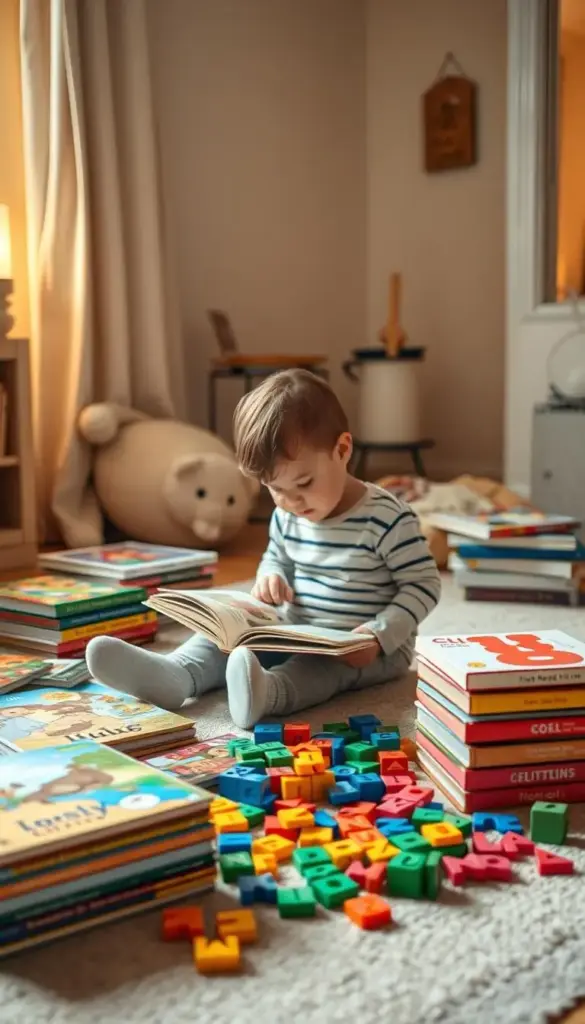
By adding these activities to your daily routine, you support your toddler’s education. You also help them develop a love for learning.
Math and Number Concepts for Tiny Learners
Math for toddlers is more than just counting. It’s about exploring the world through numbers and shapes. At this age, kids start to understand how many things there are and how they relate. Making math fun and interactive helps your toddler build a strong math foundation.
Counting Games Using Household Items
One easy way to introduce math to your toddler is with counting games at home. You can count:
- Toys during playtime
- Steps as you walk
- Blocks or Legos as you build
- Fruits or snacks during mealtime
These games teach counting and help your child learn about one-to-one correspondence.
Shape and Pattern Recognition Activities
Understanding shapes and patterns is key in math. You can engage your toddler in activities like:
- Sorting objects by shape or color
- Creating patterns with blocks or toys
- Identifying shapes in everyday objects
- Using shape sorters or puzzles
These activities boost your child’s spatial awareness and problem-solving skills.
Measurement and Comparison Exercises
Teaching measurement and comparison skills can be both fun and educational. Try:
- Comparing the lengths of objects using terms like “longer” and “shorter”
- Measuring ingredients while baking
- Comparing weights of different objects
- Using cups or containers to demonstrate volume
These exercises help your toddler understand measurement and comparing different quantities.
Sensory and Exploratory Learning Opportunities
Getting your toddler involved in sensory activities boosts their brain and motor skills. These activities help them become curious, creative, and understand the world better.
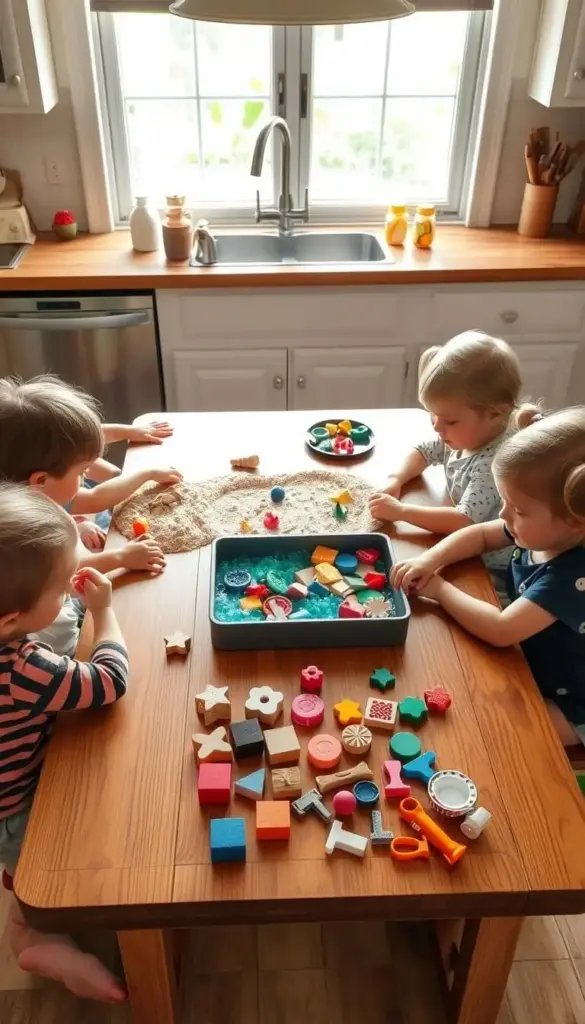
Safe Science Experiments for Toddlers
Simple science experiments can spark exploratory learning. For instance, making a homemade lava lamp is fun and educational. It mixes vegetable oil, water, food coloring, and Alka-Seltzer tablets in a bottle. This teaches toddlers about density and chemical reactions.
Another fun experiment is the baking soda volcano. Mixing baking soda and vinegar creates a chemical reaction that looks like a volcanic eruption. It’s both fun and teaches about cause and effect.
Sensory Bins and Tactile Learning
Sensory bins offer tactile learning for toddlers. Fill bins with rice, beans, sand, or water and add objects for them to find. For example, hiding small toys in a rice bin helps improve fine motor skills and hand-eye coordination.
- Fill a bin with dry beans and add small toys or other objects for your toddler to find.
- Create a water play bin with cups, spoons, and other utensils for your child to experiment with.
- Make a sand bin with molds and other tools for your toddler to build and create.
Nature Exploration and Outdoor Learning
Nature is full of sensory learning opportunities. Outdoor adventures are incredibly enriching. You can go on a nature walk, collect leaves, or simply observe the surroundings. Encourage your child to touch, smell, and listen to the environment.
| Nature Activity | Learning Benefit |
|---|---|
| Nature Walk | Observing different plants and animals |
| Leaf Collection | Understanding different textures and colors |
| Garden Exploration | Learning about growth and gardening |
By adding these sensory and exploratory activities to your toddler’s daily routine, you make learning fun. You also set a strong foundation for their future academic success.
Social and Emotional Development Through Play
Play is a powerful tool for fostering social and emotional development in toddlers. Through play, your child learns to interact with others, understand and manage their emotions, and develop essential life skills.
Playdate Learning Opportunities
Organizing playdates is an excellent way to encourage socialization and emotional development in toddlers. During playdates, children learn to share, cooperate, and resolve conflicts. You can facilitate these interactions by:
- Arranging regular playdates with other toddlers
- Encouraging group activities like building blocks or playing with playdough
- Modeling positive social behaviors like sharing and taking turns
Teaching Sharing and Cooperation
Teaching toddlers to share and cooperate is key for their social development. You can promote these skills by:
- Playing games that require taking turns, like rolling a ball back and forth
- Using real-life scenarios to demonstrate the value of sharing, such as sharing toys with friends
- Praising your child when they exhibit sharing and cooperative behavior
Emotional Intelligence Activities for Toddlers
Emotional intelligence is the ability to understand and manage one’s emotions. You can help your toddler develop emotional intelligence through activities like:
- Labeling and validating their emotions, e.g., “You seem angry right now.”
- Reading stories that depict different emotions and discussing how characters feel
- Engaging in role-playing to practice different social scenarios and emotional responses
By incorporating these strategies into your daily routine, you can support your toddler’s social and emotional development. This lays a strong foundation for their future well-being and success.
Technology and Digital Resources for Toddler Learning
In today’s world, using technology in homeschooling can really help. The right tools make learning fun and interactive for your toddler.
Age-Appropriate Educational Apps and Shows
Choosing the right digital content for your toddler is key. Look for apps and shows that teach through fun. This includes:
- Apps that teach shapes, colors, and numbers
- Shows that help with language and reading
- Games that improve problem-solving
Popular apps for toddlers include ABCmouse, PBS Kids, and Toca Life. They offer lots of activities to keep young minds engaged.
Setting Healthy Screen Time Limits
Technology is great for learning, but it’s important to limit screen time. The American Academy of Pediatrics suggests 1 hour a day of educational content for kids aged 2-5.
To keep screen time healthy, try these tips:
- Make some areas of your home screen-free, like the dinner table or bedrooms
- Set a daily schedule for screen time
- Encourage playing outside and being active
Interactive Digital Learning Tools
There are many digital tools that can make learning fun for your toddler. These include:
- Interactive e-books that make stories come alive
- Digital puzzles and games that help solve problems
- Virtual science experiments that spark curiosity
Using these tools in your homeschooling can give your toddler a rich and engaging learning experience.
Conclusion: Embracing the Toddler Homeschooling Journey
Starting your toddler homeschooling journey is exciting. Remember, a structured learning schedule is just the start. It’s also about being flexible and adapting to your child’s needs and learning style.
Creating a balanced routine can help your child love learning forever. Homeschooling routines should be tailored to each child. They need patience, creativity, and a willingness to change as needed.
Keep an open mind for new experiences and methods to improve your child’s learning. With a thoughtful and flexible homeschooling approach, you can create a supportive environment for your toddler’s growth.
FAQ
How do I create a homeschooling routine for my toddler?
To start, understand your toddler’s learning style and needs. Set realistic goals for their education. Choose a dedicated learning space and create a daily schedule.Make sure the schedule is both structured and flexible. This balance helps your toddler learn best.
What are some fun learning activities for toddlers?
Fun activities for toddlers include storytime and vocabulary games. Early writing and drawing are also great. Math games like counting and shape recognition are fun too.Measurement and comparison exercises are also engaging. These activities help your toddler learn in a playful way.
How can I make learning fun for my toddler?
To make learning fun, add play to your homeschooling. Use digital tools that interact with your toddler. Provide different sensory experiences.Try sensory bins, nature walks, and safe science experiments. These activities keep learning exciting.
How do I balance structure and flexibility in my homeschooling routine?
Balance structure and flexibility by having a daily schedule. Include regular breaks and physical activity. Be ready to adjust the schedule as your toddler grows and changes.
What are some tips for optimizing toddler education?
Understand your toddler’s learning style and set realistic goals. Create a good learning environment. Use various teaching methods, like play and digital tools.
How can I assess my toddler’s progress in a homeschooling routine?
Regularly observe your toddler’s learning and adjust your teaching. Use tools like developmental milestones checklists to track their progress.
What are some age-appropriate educational apps and shows for toddlers?
Age-appropriate apps and shows include PBS Kids and Sesame Street. ABCmouse is also great. Try educational apps like Khan Academy Kids and Duolingo.
How can I set healthy screen time limits for my toddler?
Set a daily screen time routine and stick to it. Use parental controls to limit apps and websites. Encourage physical activity and outdoor play.
What are some creative learning ideas for toddlers?
Try sensory bins, nature walks, and art projects. Cooking, music, and storytelling are also great. These activities make learning fun and engaging.



